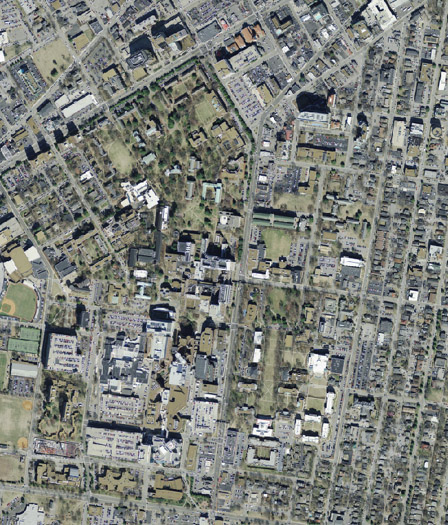Facts about the Arboretum
-

The arboretum is an island of trees in an urban sea The entire Vanderbilt campus is designated as an arboretum. In 2013 the campus contained 6181 identified and geolocated trees and shrubs. Each year 150 to 200 new trees are planted to replace trees that die or as landscaping for new construction.
- There are approximately 190 species of trees and shrubs in the arboretum.
- The oldest and most famous tree on campus was the Bicentennial Oak but alas, it fell down in 2022.
- There is a tie for largest tree in the arboretum.
- Vanderbilt was first referred to as an arboretum in May 1879, only six years after the university was founded (“Catalogue of the Species and Varieties of Plants in the Vanderbilt Arboretum“, Vanderbilt University Archives).
- The most common tree species on campus is Magnolia grandiflora (southern magnolia) with 545 representatives. The two hackberry (Celtis) species on campus commonly hybridize in the Nashville area, making it virtually impossible to identify them to species. The total number of northern hackberry (Celtis occidentalis), sugarberry (Celtis laevigata), and unidentified hackberries (Celtis spp.) is 500, making “hackberry” the second most common recognizable tree on campus. Acer saccharum (sugar maple) takes third place with 488.
- The symbol of Vanderbilt is the white oak tree (Quercus alba). However there are only 53 white oak trees on campus, putting it in third place among the oaks at Vanderbilt (after 178 willow oaks – Quercus phellos and 88 pin oaks – Quercus palustris). There are a total of 16 species of oaks (Quercus) present on campus – the most well-represented genus in the arboretum.
Urban legends
Legend: The arboretum contains every species of tree in Tennessee.
Fact: Not true. There are a number of native species not represented, such as Crataegus harbisonii, Fraxinus quadrangulata, Aralia spinosa, etc.
Legend: Somebody gave a million dollars to label the trees
Fact: Not true. This legend originates from incorrect information in a 1987 Vanderbilt Register article which was subsequently corrected in Vanderbilt Register vol. VII no. 40 p.2 (July 10, 1987). The actual amount given in 1968 was $15,000 into an endowment to honor James Mapheus Smith. For more information, see the history of the arboretum.
Legend: In order to be an arboretum, Vanderbilt has to …
Fact: There are actually no particular requirements to be called an arboretum. However, in 1988 the campus was registered with the American Public Gardens Association (APGA) as an arboretum. In October 2020, the arboretum was accredited as a Level II arboretum by ArbNet, the international arboretum certification organization. Vanderbilt’s arboretum achieved this level by meeting several criteria, including a minimum number of 100 species of trees, and carrying out educational programming.
Legend: The arboretum contains seven Tennessee state champion trees.
Fact: In 1994, the arboretum did have seven champion trees, and this was recorded in The Trees of Vanderbilt, p.7. However, since that time at least five have died and two have been dethroned by larger trees elsewhere. No state champions remain.
Legend: There is a haunted graveyard somewhere on campus.
Fact: There actually are several graves on campus. Bishop McTyeire, an important figure in the early history of the university, had the graves of several important local bishops moved to campus soon after the university started. Landon C. Garland, the university’s first chancellor was buried at the same site. McTyeire himself is also buried there; in Chancellor Kirkland’s inagural address in 1893 he noted “under the shade of magnolias that his own hand planted, he sleepeth well”. Those magnolia trees (east tree, west tree) still grow there today next to the stone monument that marks the burial site.
Video Introduction to the Arboretum
This video was created by Elizabeth Hall as a final project for her film production class in April, 2017.